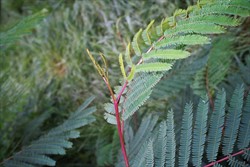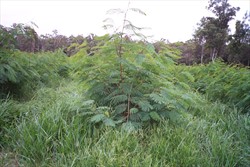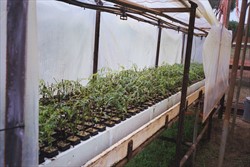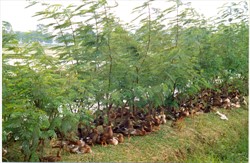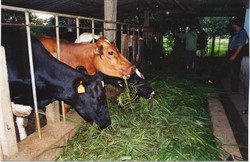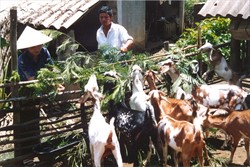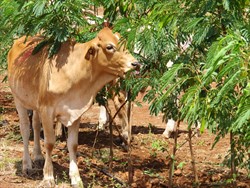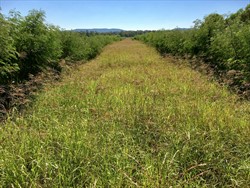Leucaena spp. hybrids
Tropical Forages
Leucaena spp. artificial hybrids
Leucaena pallida × Leucaena leucocephala ssp. glabrata
Leucaena diversifolia × Leucaena leucocephala ssp. glabrata
Leucaena esculenta × Leucaena leucocephala ssp. glabrata
Leucaena trichandra × Leucaena leucocephala ssp. glabrata
Leucaena leucocephala ssp. glabrata × Leucaena leucocephala ssp. glabrata
Note: These artificial, interspecific hybrids have been developed for forage and fuelwood production. Two naturally occurring hybrids are described by Hughes (1998), but are not listed here. Leucaena × spontanea (L. diversifolia × L. leucocephala ) and Leucaena × mixtec (L. esculenta × L. leucocephala ) are common in parts of Mexico.
These are all synthetic hybrids with no published synonyms.
Family: Fabaceae (alt. Leguminosae) subfamily: Caesalpinioideae (mimosoid clade*) tribe: Mimoseae.
* Azani, N. et al. [97 authors from 54 institutions] 2017. A new subfamily classification of the Leguminosae based on a taxonomically comprehensive phylogeny. Taxon 66: 44–77.
In general, the morphological traits of hybrid accessions are intermediate between the parental accessions. Where hybrids have parents of different ploidy levels the morphology will generally be biased towards the parent of higher ploidy level due to the recognized dosage effect. See fact sheets for morphological details of parent species.
English: leucaena
The hybrids reported in this section have been artificially produced for specific purposes and have no natural distribution.
Soil requirements
In their native range, Leucaena spp. grow on shallow limestone soils, coastal sands and seasonally dry, self-muching vertisol soils of pH 7.0‒8.5. In exotic locations they require well-drained soils with pH (H2O) above 5.5, or above 5.0 where aluminium saturation is very low. Some hybrids have improved acid soil tolerance compared with L. leucocephala, but, in general, the hybrids are intolerant of soils with low pH, low P, low Ca, high aluminium saturation, and are sensitive to high salinity and waterlogging.
Moisture
The artificial hybrids require adequate soil moisture to express their improved growth potential and are unlikely to achieve this in very dry environments. Optimum growth will be achieved in subhumid and humid climates of 1,000‒2,500 mm and up to 3,500 mm annual rainfall in environments with no distinct dry season. Reasonable growth will be achieved in drier environments (above 600 mm/year).
Temperature
KX2, KX3 and K1000 hybrids generally possess some cold adaptation in comparison with L. leucocephala, although light frosts will kill leaf and very heavy frosts will kill stems back to ground level. Require temperatures of 25‒30 ºC for optimum growth. Growth ceases at 14‒15 ºC.
Light
Unknown, but likely to be similar to L. leucocephala, being productive under moderate shade to 60% of photosynthetically active radiation (PAR).
Reproductive development
KX2 F1 hybrids are self-incompatible, but segregate strongly in subsequent generations with many individuals becoming self-fertile. They generally flower into shortening days and produce only light seed crops. KX3 hybrids are self-fertile. K1000 is sterile and will flower profusely but will not produce seed.
Defoliation
Extremely tolerant of regular defoliation by cutting, but marginally less persistent than L. leucocephala under grazing. L. leucocephala growing on a poorly drained podsolic in southeast Queensland, Australia had a half-life of 23 years under regular grazing, but much longer life span can be expected under favourable conditions.
Fire
Mature plants are tolerant of moderate intensity fires, regrowing readily from burnt stumps.
Guidelines for establishment and management of sown forages.
Establishment
Hybrids generally have a more rapid establishment than L. leucocephala. Essential to control competition from weeds. For best results plant on deep, well drained soils with a pH >5.5 and maintain a weed-free area of at least 2 m either side of the establishing plants. Seed must be scarified to break the impermeable testa. Previously, hot-water treatment was recommended but resulted in highly variable results including reduced viability. Mechanical scarification, using coarse sandpaper (for small seed lots) or abrasive-lined rotating drum scarifiers, is now preferred. Specific rhizobium is required (e.g. CB 3060, TAL1145, LDK4).
Complete cultivation is recommended for extensive plantings. Planted into rows 4‒9 m apart at seeding rates of 1.5‒3.0 kg/ha. Rolling cultivators can be used to control very young weed seedlings and break soils crusts before or after emergence of leucaena seedlings. Small areas can be planted using seed or seedlings. Seedlings are normally raised in poly bags for plug planting at 3‒4 months old. Seedlings can also be raised in beds and removed for planting as bare-rooted seedlings if 'topped and tailed'.
Fertilizer
Normally not fertilized under rain-grown conditions. Starter N and P may be used when establishing into depleted soils on cropping lands. Leucaena in Australia has occasionally responded strongly to added sulphur. On acid-infertile soils it is essential to add lime, P and K at planting and after each cut. Hybrid leucaenas are planted into acid soils in northern Vietnam using a similar system as for planting of citrus, viz. digging a hole of 0.5‒0.75 m³ and filling with lime, composted manure and topsoil. Trees are fertilized with compost annually.
Compatibility (with other species)
Compatible with a range of grass and legume species. Can be difficult to establish leucaena into existing grass pastures without clean cultivation or removal of competition. Height management is essential to prevent rapidly growing hybrids from growing out of reach of grazing livestock. This can be achieved through a combination of grazing and slashing.
Companion species
Grasses: Hybrids have been grown experimentally with Urochloa decumbens in Papua New Guinea and wet tropical Australia and with Imperata cylindrica in Indonesia and the Philippines.
Normally grown as a hedgerow with grasses or crops grown between hedgerows. Can be grown as a sole species in a forage bank.
Pests and diseases
Many hybrids were initially bred for resistance to the psyllid, Heteropsylla cubana, a small aphid-like sucking insect that reduces production of all L. leucocephala cultivars and accessions. KX2 F1 and K1000 hybrids are highly psyllid-resistant, whereas some of the advanced generation hybrids have only moderate resistance.
Newly emerged nursery and field-grown seedlings are susceptible to damping-off diseases caused by the fungal species Pythium or Rhizoctonia.
Soil insects such as earwigs, scarab beetles, termites and cut worms can cause serious damage to emerging seedlings and should be controlled.
Seed production can be reduced by the flower-eating larvae of the moth Ithome lassula, and by seed-eating bruchid beetles.
Other pests and diseases that attack L. leucocephala may also attack Leucaena hybrids.
Ability to spread
Will not normally spread under grazing as cattle, goats and sheep relish young seedlings.
Weed potential
K1000 has no weed potential, being a sterile triploid. Other leucaena hybrids are known to be shy seeding and are commonly self-incompatible, thereby reducing their weed potential. Where trees are permitted to seed, segregation among the resultant seedlings may re-establish self-compatibility, higher seed production, and higher weed risk.
Nutritive value
Forage hybrids have similar crude protein concentrations to L. leucocephala (20‒37%). Hybrids contain varying concentrations of condensed tannins (CTs). KX2 F1 contains higher concentrations (3‒7%) of CTs than L. leucocephala (2-5%), but lower concentrations than for L. pallida (5‒17%). From feeding and grazing trials it is apparent that the measurable, but minor reduction in nutritive value of KX2 F1 is the result of the increased CT concentration.
Palatability/acceptability
KX2 F1 is highly palatable to most grazing animals, especially compared to other forage tree legumes such as Calliandra calothyrsus and Gliricidia sepium. KX2 F1 ranked together with L. leucocephala accessions as being highly palatable to sheep and cattle in cafeteria trials in Australia and the Philippines. K1000 is probably the least palatable of the hybrids due to the low palatability of the L. esculenta parent.
Toxicity
Contains mimosine, a non-protein amino acid that has antimitotic and depilatory effects on animals. Concentrations in the edible fraction of KX2 F1 ranged from 2‒3% mimosine, considerably lower than for L. leucocephala. Mimosine is acutely toxic to animals but is normally converted to 3-hydroxy-4(IH)-pyridone (DHP) upon ingestion. DHP is goitrogenic and, if not degraded, can result in low serum thyroxine levels, ulceration of the oesophagus and reticulo-rumen, excessive salivation, poor appetite and low liveweight gains, especially when the diet contains more than 30% leucaena. In most countries in the Americas and southeast Asia, rumen microbes can completely detoxify DHP and specific DHP degrading bacteria have been identified and transferred to Australia, USA, Africa and China.
Dry matter
Very high forage yields have been recorded for KX2 hybrids in southeast Asia, Australia and Hawaii, producing >15 t/ha/year DM with plants 0.5‒1.0 m apart, in rows 1‒3 m apart. KX2 F1 hybrid was extremely vigorous in agronomic trials throughout southeast Asia and Australia, generally outperforming other Leucaena accessions by 20‒100%. Mean yields of 360 g/m row/month DM were achieved from a range of KX2 F1 hybrids grown in line plots at 18 sites in 7 countries. Under regular cutting, advanced generation KX2 and KX3 hybrids were considerably lower yielding compared with KX2 F1 hybrids.
In subtropical Australia, wood yields of KX2 F1 hybrid trees grown in line plots averaged 37 kg/tree/year DM over a two-year period and were nearly double the yield of the best non-hybrid accessions. Advanced generation KX2 and KX3 hybrids averaged 20 kg DM/tree/year. Few details are available for DM yields of other leucaena hybrids.
Animal production
Relatively few animal production experiments have been conducted with hybrid accessions. In subtropical Australia, cattle grazing KX2 F1 hybrid leucaena produced liveweight gains of 0.5 kg/head/day over a 4-month period, in comparison with L. leucocephala and L. pallida, which supported liveweight gains of 0.6 and 0.3 kg/head/day respectively. In northern Vietnam, lactating goats maintained milk production when concentrate feeds were replaced with KX2 F1 hybrid forage.
The University of Hawaii has undertaken considerable research to determine ploidy levels, chromosome numbers and cross-compatibility among species of Leucaena (see Brewbaker and Sorensson 1994 or Hughes 1998). Several hybrids were developed and evaluated through this program. MARDI, Malaysia and EMBRAPA, Brazil, collaborated to produce the acid-soil tolerant hybrids 'Bharu' and 'Rendang'. The University Federal do Rio Grande do Sul, Brazil is currently conducting a program to develop cold-tolerant leucaena hybrids. The University of Queensland, Australia is currently conducting a program to develop a psyllid-resistant KX2 hybrid.
There is considerable interest in producing sterile triploid accessions by crossing tetraploid and diploid species for forage and timber production. Sterility will overcome the weed threat posed by leucaenas in some environments.
In central Queensland, Australia (23º S) peak flowering of KX2 occurs from February to April, although trees may not flower in their first year. Little known regarding the potential seed yields, but they are expected to be as low as 100 kg/ha/year.
Herbicides such as bentazone (post-emergence) and imazethapyr (post-plant) can be used to control weeds in establishing leucaena hybrids. Leucaena spp. can be controlled by basal bark application of herbicides containing 120 g/L picloram and 240 g/L triclopyr mixed with diesel. Glyphosate will kill slashed regrowth although repeat applications may be necessary.
- Most hybrids exhibit extremely vigorous growth, given suitable soil moisture.
- Higher psyllid resistance than L. leucocephala, especially KX2 F1 and K1000.
- More broadly adapted, including low temperature adaptation (not frost tolerance) and moderate adaptation to acid-infertile soils.
- Recurrent selection programs are making seed more readily available.
- Seed of F1 hybrids is very expensive and available only in limited quantities.
- KX2 F1 hybrids do not breed true to type and are moderately difficult to produce from stem cuttings .
- Forage quality of KX2 is slightly lower than that of L. leucocephala
- Advanced generation hybrids are generally less productive than F1s.
https://www.agric.wa.gov.au/sites/gateway/files/Hughes%2C%20Colin%20-%20Leucaena-species%20diversity%20and%20genetic%20resources.pdf (Leucaena: species diversity & genetic resources)
Brewbaker, J.L. and Sorensson, C.T. (1994) Domestication of lesser-known species of Leucaena. In: Leakey, R.R.B. and Newton, A.C. (eds) Tropical trees: the potential of domestication and rebuilding of forest resources. HMSO, London, UK. p. 195–204. bit.ly/2UPHVY6
Dalzell, S.A. (2019) Leucaena cultivars – current releases and future opportunities. Tropical Grasslands-Forrajes Tropicales 7:56–64. doi.org/10.17138/tgft(7)56-64
Hughes, C.E. (1998) Leucaena, A genetic resources handbook. Oxford University Press, Oxford, UK. bit.ly/2Iw31af
Mullen, B.F., Shelton, H.M., Gutteridge, R.C. and Basford, K.E. (2003) Agronomic evaluation of Leucaena. Part 1. Adaptation to environmental challenges in multi-environment trials. Agroforestry Systems 58:77–92. doi.org/10.1023/A:1026068215337
Shelton, H.M., Gutteridge, R.C., Mullen, B.F. and Bray, R.A. (eds). (1998) Leucaena - adaptation, quality and farming systems. Proceedings of a Workshop Held in Hanoi, Vietnam, 9–14 February 1998. ACIAR Proceedings No. 86. Australian Centre for International Agricultural Research (ACIAR), Canberra, Australia. p. 247–252. purl.umn.edu/135197
Note: Detailed updates on knowledge relating to Leucaena were provided in papers presented at the International Leucaena Conference held at The University of Queensland, Brisbane, Australia, 1‒3 November 2018. All papers were published under a publication agreement with the Organizing Committee in two Special Issues of Tropical Grasslands-Forrajes Tropicales: ILC2018 No. 1 - May 2019 Vol 7, No 2. 24 papers presented during Sessions 1‒4 of the Conference. http://www.tropicalgrasslands.info/index.php/tgft/issue/view/29/showToc and ILC2018 No. 2 - September 2019 Vol 7, No 4. 36 papers presented during Sessions 5‒8 of the Conference. http://www.tropicalgrasslands.info/index.php/tgft/issue/view/31/showToc.
'KX2' hybrids University of Hawaii (1990). Refers to a range of L. pallida × L. leucocephala hybrid accessions (F1‒F6), but predominantly K376 × K8. Developed as psyllid resistant forage/fuelwood species. Released for widespread evaluation in the early 1990s. The program culminated in the release of 'Ohana'.
'KX2 Ohana' University of Hawaii (1996). From an original cross between L. pallida K376 and L. leucocephala ssp. glabrata K8. Developed over 6 cycles of recurrent selection to produce a high yielding, psyllid-resistant hybrid for tropical low to mid-elevation environments.
'KX3' hybrids University of Hawaii (1990). Refers to a range of L. diversifolia × L. leucocephala hybrid accessions (F1‒F4), but predominantly K156 × K8. Developed as psyllid resistant fuelwood/forage species. Released for widespread evaluation in the early 1990s.
'K1000' University of Hawaii (1998). L. esculenta × L. leucocephala ssp. glabrata hybrid. A very fast-growing, sterile hybrid with potential as an amenity shade tree. Can be easily propagated from stem cuttings.
'LxL' Released in Hawaii (1996). Developed from 5 clonal interspecific L. leucocephala F1 hybrids, viz. K397 × K565, K584 × K636, K608 × K565, K608 × K397 and K397 × K608. Developed for forage production in subtropical locations. High yielding in Hawaii.
'Bharu' KX3, Malaysian Agricultural Research and Development Institute (MARDI) (1998). Developed as a psyllid-resistant and acid soil tolerant forage and fuelwood cultivar. Based on a hybrid between L. leucocephala ssp. glabrata and L. diversifolia .
'Rendang' MARDI (1998). Developed as a psyllid resistant and acid soil tolerant forage cultivar. Based on a hybrid between L. leucocephala ssp. glabrata and L. trichandra .
'Wondergraze' Granted PBR protection in Queensland, Australia (2010). Developed by controlled pollination (emasculated and hand pollinated flowers) of two elite accessions,‘K584’ × ‘K636’ (syn. cv. Tarramba) of Leucaena leucocephala ssp. glabrata to create an intraspecific hybrid. Highly self-fertile (<1% outcrossing). Higher forage yield, more tolerant of psyllid attack and cold weather than 'Peru' and 'Cunningham'; seedling vigour similar to 'Tarramba'; shorter and more bushy than 'Tarramba'.
'Redlands' (BL 12) Granted PBR protection in Queensland, Australia (2017). Controlled pollination: Leucaena pallida × Leucaena leucocephala. After three generations of random mating among Leucaena pallida × Leucaena leucocephala hybrid trees with selection for resistance to the leucaena psyllid (Heteropsylla cubana) as well as branching habit during each cycle, elite trees were then selected for a backcrossing program. ‘Wondergraze’ was used as the recurrent parent in three backcrosses with selection for psyllid resistance, branching type, self compatibility and foliage digestibility.
KX2 F1 University of Hawaii (1990), University of Queensland (1998), Forest Science Institute of Vietnam (2000). The original hybrid, K748 × K636 was produced by the University of Hawaii. A subsequent reciprocal hybrid (K636 × K748) was produced by the Forest Science Institute of Vietnam. These have been extensively evaluated and promoted for ruminant production in Southeast Asia and Australia by the University of Queensland. Uptake by farmers has been hampered by the necessity to produce seed by manual pollination, or cuttings by vegetative propagation from stem cuttings.
KX3 selections University Federal do Rio Grande do Sul, Brazil. Developing cold-tolerant hybrids for southern Brazil.
BL 39 L. pallida × L. leucocephala University of Queensland (2014). Accepted for PBR protection 2014.
